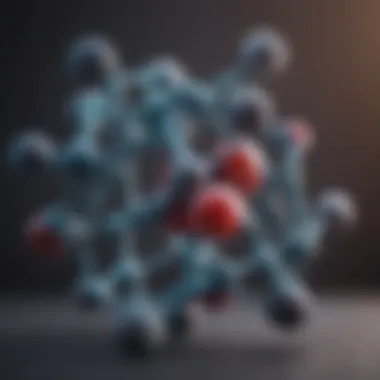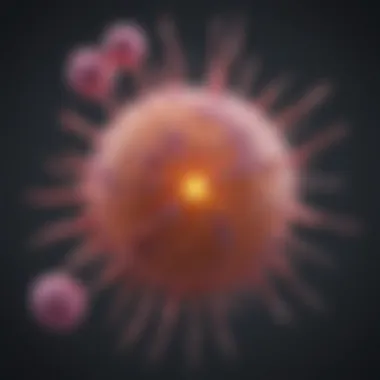Comprehensive Guide to Anti-Cancer Medications


Intro
In the ever-evolving landscape of oncology, a profound comprehension of anti-cancer medications becomes ever more crucial. These medications play a pivotal role in the fight against cancer, and understanding their assorted mechanisms, types, and implications can vastly influence treatment trajectories.
The significance of this subject resonates through clinical settings and academic circles alike. For clinicians, a robust knowledge of these medications enhances their ability to tailor treatments to individual patient needs, especially with the advent of personalized medicine. Conversely, patients equipped with this knowledge can engage more effectively in their treatment processes, potentially leading to better outcomes.
Let us embark on an analytical journey that deftly unpacks the complexities surrounding these essential therapeutic agents, culminating in an enriched understanding for readers spanning from students and researchers to industry professionals.
Foreword to Anti-Cancer Medications
Anti-cancer medications hold a pivotal role in the fight against malignancies, providing patients with tangible hope in the face of what can often feel like a daunting disease. Understanding these medications is not just limited to grasping their chemical structures or typical side effects; it extends into the complexities of their mechanisms, efficacy, and the considerations each treatment entails. By delving into this subject, we come to appreciate how these drug therapies shape the trajectory of cancer treatment strategies.
The Importance of Anti-Cancer Medications
In an era where cancer represents a significant health burden worldwide, anti-cancer medications are central to most treatment regimens. They significantly improve survival rates and can even lead to complete remission in some cases. The importance of these medications cannot be overstated, as they are often the cornerstone for many patients undergoing treatment, allowing them to lead fuller lives amidst battling their illness.
Moreover, the development of newer classes of medications, such as immunotherapy and targeted therapies, further enriches treatment options, opening doors for personalized approaches tailored to individual patient profiles.
"The treatments we have today are not just about extending life; they aim to enhance its quality."
Patients and their families must stay informed about these medications, understanding their roles and implications. Knowledge empowers decision-making, enabling better conversations with healthcare providers and more personalized care plans.
A Historical Overview
The journey of anti-cancer medications is storied and complex, intertwining scientific breakthroughs with patient narratives. It all started in the 1940s with the introduction of nitrogen mustards, the first chemotherapy agents, that were essentially derived from warfare agents. They revolutionized how we approach cancer treatment but came with significant side effects and limitations.
In the following decades, more drugs were introduced. The late 20th century ushered in anthracyclines and taxanes, which were more effective against certain cancers and improved patient outcomes. These developments were often a result of rigorous research and clinical trials, underscoring the importance of empirical evidence in medical advancement.
Recent years have seen a shift from broad-spectrum chemotherapeutic agents to highly targeted therapies designed to attack specific cancer cells while sparing healthy ones. This evolution has not only improved efficacy but also minimized adverse effects, allowing patients to retain their quality of life during treatment.
Overall, understanding the historical context of anti-cancer medications helps shed light on current challenges and future directions in oncology, as each new advancement builds upon lessons learned from the past.
Mechanisms of Action
Understanding the mechanisms of action for anti-cancer medications is crucial. This knowledge not only guides the development of more effective treatment strategies but also enhances our grasp of how these drugs alter cancer cell behavior and improve patient outcomes. In an ever-evolving field, appreciating these mechanisms becomes essential for healthcare providers, researchers, and patients alike.
Targeting Cancer Cell Growth
One crucial approach in cancer treatment is targeting cancer cell growth. Medications designed to disrupt the growth process can play a pivotal role, often leading to significant improvements in patient prognosis.
Inhibition of Mitosis
Inhibition of mitosis is a cornerstone of cancer treatment due to its direct impact on cell division. Cancer cell’s rapid proliferation hinges on successful mitosis, and interrupting this process can lead to cell death or the cessation of growth. This method is beneficial because it targets a fundamental aspect of how cancer spreads.
A hallmark of inhibitors is their ability to lock onto specific proteins involved in the mitotic process, thus blocking those cells from successfully dividing. This targeted approach ensures that cancerous cells, which tend to divide uncontrollably, are disproportionately affected compared to normal cells.
However, there are downsides. The unique interaction with rapidly dividing cells may also impact healthy tissues, leading to undesirable side effects such as nausea or hair loss. Balancing effectiveness with the quality of life outcomes makes this a critical consideration.
Apoptosis Induction
Apoptosis induction serves as another powerful mechanism within the anti-cancer arsenal. This process prompts programmed cell death, a natural way for the body to eliminate cells that are damaged or dysfunctional. It’s highly influential because it specifically targets cancer cells that have found a way to evade normal death signals.
The key characteristic of apoptosis induction is its precision. By encouraging cancer cells to self-destruct, it reduces the risk of unwanted side effects often seen with other treatments that might harm healthy cells. The apoptotic pathway can be activated by various medications, which opens up avenues for innovative therapies aimed specifically at exploiting this natural process.
Nevertheless, challenges persist. Not all cancer cells respond to apoptotic signals equally, and finding the right balance in treatment protocols remains a work in progress in the field.
Interference with DNA Repair


The ability to repair DNA is crucial for the survival of cells, particularly cancer cells that have distinct mechanisms allowing them to fix damage. Medications that interfere with DNA repair processes can hinder their growth significantly, making this a vital tactic in oncology. When cancer cells are unable to repair their DNA, they accumulate damage that can lead to their destruction or erratic growth patterns, which can be more easily targeted by other treatments.
Targeted Therapy Mechanisms
Targeted therapy represents a leap forward in the fight against cancer. Unlike traditional methods, which often target all rapidly dividing cells, targeted therapies focus on specific pathways and markers associated with tumor growth.
Monoclonal Antibodies
Monoclonal antibodies have gained recognition for their ability to hone in on specific antigens found on the surface of cancer cells. This specificity not only enhances efficacy but also reduces collateral damage to healthy cells. These tailor-made proteins can flag cancer cells for destruction by the immune system or can deliver toxic agents directly.
A significant advantage of monoclonal antibodies is their adaptability. They can be engineered to bind to a variety of targets, allowing for personalized treatment plans based on individual tumor characteristics. However, they can also be resource-intensive to produce and can take time to start showing effects.
Small Molecule Inhibitors
Small molecule inhibitors are lauded for their ability to penetrate cells and interfere with specific signaling pathways. These compounds can effectively block the mechanisms that allow cancer cells to proliferate and survive. Their small size enables them to disrupt the function of proteins, thereby halting growth by starving cancer cells of necessary signals.
The flexibility of small molecule inhibitors is a major advantage. They may be combined with other treatments to create synergistic effects, potentially improving outcomes for patients. Nonetheless, they can face challenges such as the development of resistance, leading to a need for ongoing study and adaptation of treatment protocols.
This multi-faceted approach in the mechanisms of action highlights how anti-cancer medications adapt to target the unique aspects of tumor biology, making significant strides in cancer management.
Types of Anti-Cancer Medications
The landscape of cancer treatment is diverse and that diversity is reflected in the various types of anti-cancer medications available. Understanding these can empower both practitioners and patients in making informed decisions. Each category of medication targets the disease through unique mechanisms, aiming to inhibit growth, kill cancer cells, or enhance the body’s natural defenses. This section explores the array of anti-cancer drugs, focusing on their characteristics, benefits, and the considerations that accompany their use.
Chemotherapy
Chemotherapy remains one of the most well-known and utilized forms of anti-cancer treatment. This approach involves the use of drugs that target rapidly dividing cells, a hallmark of cancer. It’s frequently employed when aiming to shrink tumors prior to surgery or to prevent recurrence after surgical removal of a tumor.
Alkylating Agents
Alkylating agents are a cornerstone in the arsenal of chemotherapy agents. They work by adding an alkyl group to the DNA molecule, which results in cross-linking of the DNA strands. This prevents the cancer cell from successfully replicating its DNA, ultimately leading to cell death. A significant characteristic of alkylating agents is their potential effectiveness against a broad spectrum of cancers, from leukemias to lymphomas. However, a notable downside is their association with secondary malignancies due to DNA damage, underscoring the balance of risks and benefits inherent in cancer treatment.
Antimetabolites
These agents mimic the building blocks of DNA and RNA, thereby disrupting the synthesis of nucleic acids. Antimetabolites such as methotrexate and 5-fluorouracil are potent in targeting cancers that are highly reliant on these biological processes, particularly in fast-growing tumors. Their unique feature lies in their ability to inhibit DNA synthesis without directly damaging DNA, offering a different mechanism compared to traditional alkylating agents. However, they can lead to adverse effects like suppression of bone marrow function, which is a critical consideration in their use.
Anthracyclines
Anthracyclines are some of the most effective chemotherapy drugs available, known for their ability to intercalate into DNA, thereby inhibiting the ability of cancer cells to divide. A prime example includes doxorubicin, frequently utilized for treating various cancers like breast and lung. Their key characteristic is their efficacy against solid tumors, but they come with a notorious reputation for cardiotoxicity, limiting their long-term use. Thus, while they provide significant benefits, this potential side effect necessitates careful monitoring of heart health during treatment.
Radiation Therapy
Radiation therapy complements chemotherapy in cancer treatment by using high doses of radiation to kill or damage cancer cells. It can target specific areas of the body, making it a useful tool for localized cancers. This treatment often occurs in conjunction with other therapies, enhancing overall efficacy.
Hormonal Therapies
Hormonal therapies focus on hormone-sensitive cancers, such as those affecting the breast and prostate. These medications work by blocking hormone receptors or lowering hormone production, thus alleviating a key driver for the growth of certain tumors. They are crucial in improving treatment outcomes for hormone-dependent cancers.
Immunotherapy
Immunotherapy leverages the body’s immune system to identify and combat cancer cells. With innovations like checkpoint inhibitors and CAR T-cell therapy, it represents a significant advancement in oncology.
Checkpoint Inhibitors
These drugs help the immune system recognize and attack cancer cells by blocking proteins that inhibit immune responses. A prominent example is pembrolizumab. The key feature here is their ability to provide durable responses even after treatment ceases, offering hope for those with advanced cancers. However, immune-related side effects can arise, demanding close monitoring and management in clinical settings.
CAR T-Cell Therapy


CAR T-cell therapy is an innovative form of immunotherapy that involves modifying a patient’s T cells to better identify and destroy cancer cells. Noteworthy for its personalized approach, this treatment has shown remarkable success in certain blood cancers. Yet, the complexity and potential for serious side effects, such as cytokine release syndrome, highlight significant challenges that still need to be addressed.
Novel Therapeutics
The realm of anti-cancer medications is constantly evolving, particularly with the emergence of novel therapeutics, which include gene therapy and personalized medicine.
Gene Therapy
Gene therapy offers the potential to correct faulty genes responsible for cancer development. This groundbreaking approach not only addresses the characteristics of specific tumors but aims at providing long-lasting solutions. Although still largely experimental for most cancers, it holds a lot of promise for future treatments.
Personalized Medicine
Personalized medicine tailors treatment based on an individual’s genetic profile, leading to more effective and targeted therapies. It is beneficial for optimizing drug choices and minimizing adverse effects, though challenges such as cost and accessibility remain areas for ongoing development.
"The advancement of anti-cancer medications reflects a commitment to not only treat but to understand cancer in its complexity.”
In summary, the variety of anti-cancer medications available today underlines a multi-faceted approach to treatment. Each type carries its own unique profile, presenting distinct advantages and challenges that must be carefully weighed in the context of patient care.
The Role of Biomarkers
Biomarkers, a term that captures considerable attention in cancer research and treatment, serve as critical indicators of disease and treatment efficacy. Essentially, they are measurable substances in the body that reflect how well the body responds to a treatment for a disease. Within the realm of oncology, biomarkers offer a plethora of benefits, especially in tailoring treatment strategies to the individual patient, ultimately aiming for improved outcomes. This section delves into the significance of biomarkers, illustrating their role in cancer therapy and the advancements made in precision medicine.
Biomarkers in Cancer Treatment
Biomarkers in cancer treatment have shifted the perspective on how therapy is approached. Traditionally, treatments were often generalized—one-size-fits-all methods. However, the modern landscape favors a more personalized strategy.
Types of Biomarkers
Biomarkers can be classified into several categories:
- Diagnostic Biomarkers: Help to identify the presence of cancer; for instance, prostate-specific antigen (PSA) in prostate cancer.
- Prognostic Biomarkers: Provide information about the likely outcome of the disease; examples include assays that determine the aggressiveness of tumors.
- Predictive Biomarkers: Assist in predicting the response to a specific treatment, making it easier to classify which therapies may be most effective for an individual.
Clinical Application
In practice, utilizing biomarkers improves treatment efficacy, reduces unnecessary side effects, and enhances the overall patient experience. For example, the identification of HER2 overexpression in breast cancer tumors allows the use of trastuzumab, a monoclonal antibody that specifically targets this protein, leading to better survival rates for patients with HER2-positive breast cancer.
"Biomarkers herald a new chapter in cancer treatment, paving the way for predictive and personalized care, which is crucial in managing this complex illness."
Predicting Treatment Response
Predicting treatment response is possibly one of the most pivotal roles of biomarkers in cancer care. By accurately assessing tumor characteristics through biomarkers, oncologists can make informed decisions about the likely success of various treatment options.
How Prediction Works
The prediction of treatment response typically takes into account:
- Genomic and Proteomic Analysis: Technology that allows the examination of the cancer at the molecular level helps unwrap the peculiarities of individual tumors.
- Biochemical Markers: These can indicate how a tumor metabolizes drugs, which is vital when selecting the right medication.
- Tumor Microenvironment Factors: Understanding the tumor's surroundings can shed light on potential resistance mechanisms.
Challenges Ahead
While these strategies hold promise, challenges remain in standardizing biomarker assessments across different populations and ensuring consistent implementation in clinical settings. Moreover, the dynamic nature of cancer, including its ability to adapt and evolve, sometimes means that biomarkers that are useful at one stage may become less relevant as the disease progresses.
The infusion of biomarkers into cancer treatment not only empowers healthcare professionals but also provides patients with hope through more tailored and potentially effective therapies. As the field continues to evolve, the interplay between biomarkers and treatment options stands at the forefront of personalized cancer medicine.
Challenges in Anticancer Pharmacology
The quest for effective treatment against cancer has always been riddled with hurdles. Understanding these challenges in anticancer pharmacology is pivotal, not just for researchers but also for clinicians and patients who rely on these medications. Two primary hurdles emerge in this landscape: drug resistance and the adverse effects of medications. Addressing these issues involves careful analysis and continual adaptation, forming a vital part of ongoing treatment strategies.
Drug Resistance
Mechanisms of Resistance
The mechanisms of resistance are characteristic processes that allow cancer cells to evade the lethal effects of anticancer drugs. One critical aspect is the ability of cancer cells to alter drug metabolism or transport. These changes can lead to either a reduced accumulation of the drug or an enhanced ability to expel it, rendering the therapy ineffective. This resistance is a double-edged sword. On one hand, understanding these mechanisms can drive research into more effective therapies; on the other, they often leave patients with fewer viable treatment options.
The uniqueness of these mechanisms lies in their diversity. For example:


- Increased drug efflux: The cancer cells express proteins like P-glycoprotein that pump drugs out before they can act.
- Target mutation: Changes in the target enzyme can render a drug useless if it can no longer bind effectively.
These factors make the study of resistance mechanisms crucial, as overcoming them might unlock pathways to improved outcomes for patients.
Overcoming Resistance Strategies
As cancer treatment evolves, the need for overcoming resistance strategies becomes apparent. These strategies play a crucial role in ensuring that existing therapies remain effective. One widely explored avenue is the use of combination therapies. By administering multiple drugs that target various pathways, oncologists can reduce the potential for a cancer cell to adapt and survive against all treatments.
One unique feature of these strategies is their flexibility. For instance, if a patient is not responding to a particular drug regimen, healthcare providers can adjust the treatment plan, incorporating newer agents or alternative therapies. This adaptability is a significant advantage as it aligns with the dynamic nature of cancer biology. However, clinicians must be cautious. The balancing act of intensifying treatment must be weighed against the patient's quality of life and potential side effects, making clinic decisions complicated yet critical.
Adverse Effects of Medications
The side effects of anticancer medications are not merely incidental; they often dictate the treatment landscape. Many of these medications can lead to significant complications, from nausea and hair loss to more severe issues like organ toxicity. This necessity for managing adverse effects highlights the delicate balance between curative intent and maintaining a patient's quality of life.
In the face of these challenges, ongoing research is essential. As we advance our understanding of cancer biology and pharmacology, the hope remains that the overcoming of resistance and the careful management of side effects will shape the future of anticancer therapy. The path is complex, no doubt, but by understanding these challenges, stakeholders can foster better communication, more tailored treatment plans, and ultimately, more successful outcomes in the fight against cancer.
"The journey to overcome cancer is a marathon, not a sprint. Understanding the barriers is the first step towards effective solutions."
Future Directions in Anti-Cancer Therapy
In the ever-evolving landscape of oncology, the future of anti-cancer therapy holds potentially transformative avenues that could reshape treatment protocols. The significance of exploring future directions is underscored by the pressing need for more effective and personalized treatment approaches. As we delve deeper into the various elements surrounding these advancements, it's crucial to examine the benefits and considerations that accompany such progress.
Advancements in Research
The research arena is buzzing with activity, as scientists and clinicians work tirelessly to uncover novel therapies that can tackle cancer more effectively. One notable focus is on immunotherapy, which is proving to be game-changing in the fight against various cancers. Researchers are exploring ways to harness the body's immune system to target and kill cancer cells, which was something thought nearly impossible just a couple of decades ago.
There’s also significant effort in the development of targeted therapies that attack specific genetic mutations involved in cancer. For instance, breakthroughs in understanding the genetic landscape of tumors provide opportunities for creating precision medicines that cater specifically to the genetic profile of individual patients. This is much more promising than the traditional ‘one-size-fits-all’ approach, offering the potential for better outcomes with fewer side effects. Additionally, the integration of artificial intelligence for drug discovery is an exciting frontier. By utilizing vast datasets, AI can help identify potential drug candidates faster than systematic laboratory methods.
The Promise of Combination Therapies
Another area that is gaining traction is the promise of combination therapies. These approaches are based on the rationale that cancer is a complex, multifactorial disease. Relying on a single treatment modality may not always yield the best outcome, therefore, combining different therapeutic agents could provide complementary actions that enhance efficacy.
- Synergy in Action: Combining chemotherapy with immunotherapy has shown substantial results in various malignancies, exploiting the strengths of both to outwit the cancer.
- Tailored Treatment Plans: Doctors may develop individualized treatment regimens that account for a patient’s specific cancer type, genetic makeup, and overall health, ensuring each patient receives the most effective combination.
- Minimizing Resistance: Utilizing multiple drugs simultaneously may deter or slow down the development of drug resistance, a common hurdle faced in cancer treatment.
These combination strategies lead us to believe that the future of anti-cancer therapies will not only focus on better medications but will also emphasize constructing multifaceted treatment plans to enhance overall patient outcomes. It sets the stage for a more nuanced understanding of cancer and reinforces the principle that treatment efficacy is often greater when employing diverse methods.
"The fight against cancer is a marathon, not a sprint. Understanding how various therapies can work together is the key to long-term success in patient outcomes."
As we gaze into the crystal ball of cancer treatment, there's an undeniable aura of hope surrounding the advancements on the horizon, promising a new era of oncology where treatments are tailored, targeted, and incredibly effective.
Ending
The conclusion serves as a pivotal point in understanding the wide-ranging influence of anti-cancer medications on treatment strategies. It is essential to recognize how these medications not only serve to combat cancer but also shape the very landscape of oncological therapy today.
The Impact of Anti-Cancer Medications
A significant element to highlight in this discussion is the profound impact that anti-cancer medications have had on patient outcomes. For instance, the advent of targeted therapies and immunotherapies significantly enhances survival rates and offers new hope to patients who previously had limited options. One such example is the development of checkpoint inhibitors, which help the immune system recognize and combat cancer cells more effectively. By turning the body’s own defenses against the disease, these therapies often reduce the need for more invasive treatments like chemotherapy and radiation, thus improving quality of life.
Furthermore, the role of biomarkers can’t be overlooked. Biomarkers provide a glimpse into how individual tumors may respond to specific treatments, tailoring therapy to each patient's unique cancer profile. This precision medicine approach not only minimizes ineffective treatments but also optimizes the therapeutic regimen, leading to better outcomes and fewer side effects.
In summary, the transformative potential of anti-cancer medications fundamentally alters the approach to cancer treatment, pushing the boundaries of what is possible in oncology.
Looking Towards the Future
As we gaze into the future of anti-cancer therapy, it becomes clear that several trends are likely to shape the field. The integration of technology in drug development is prominently at the forefront. Advances in artificial intelligence and machine learning are streamlining the discovery of new drug compounds, allowing for rapid screening of treatments that might be effective against specific cancer types.
Moreover, combination therapies are gaining traction, where multiple treatment modalities are used synergistically. The blend of traditional treatments with newer investigational drugs helps to tackle cancer from various angles, often improving the chances of success.
One notable direction is the exploration of gene editing technologies, which hold promise for the direct modification of cancerous cells. Techniques such as CRISPR are paving the way for therapies that may not only target existing cancer but also prevent new malignancies from arising.
"The future of anti-cancer medications will depend on our ability to adapt and innovate while keeping the patient at the center of treatment decisions."
With ongoing research and breakthroughs, the possibility of seeing higher survival rates and improved quality of life for cancer patients is not just a remote dream, but an impending reality.















